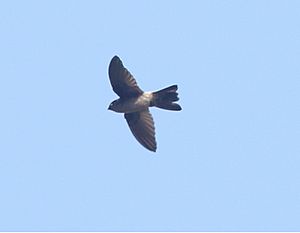Australian swiftlet facts for kids
Quick facts for kids Australian swiftlet |
|
|---|---|
 |
|
| Conservation status | |
| Scientific classification | |
| Synonyms | |
|
Collocalia terraereginae |
The Australian swiftlet (Aerodramus terraereginae) is a small bird that belongs to the swift family. It is found only in Queensland, which is in north-eastern Australia. This bird used to be considered part of the white-rumped swiftlet species. However, scientists now usually see it as its own separate species. There are two types, or subspecies, of the Australian swiftlet: A. t. terraereginae and A. t. chillagoensis, sometimes called the Chillagoe swiftlet.
Contents
About the Australian Swiftlet
This swiftlet is about 11 to 12 centimetres long. Its wings are around 10.7 to 11.8 centimetres, and it weighs about 10.5 to 12.5 grams. Its top feathers are dark grey-brown, and its belly is a plain grey. It has lighter feathers on its forehead and near its beak. The rump (the lower back) is usually light grey, but sometimes it can be darker. Its tail is slightly forked, like a shallow "V" shape. The chillagoensis type is smaller and lighter in colour, weighing about 9.39 grams.
This bird makes a high-pitched sound when it flies. Inside its breeding caves, it makes a metallic clicking sound. This sound helps the swiftlet find its way around in the dark, much like echolocation used by bats.
Where They Live
The A. t. terraereginae swiftlet lives in the tropical north-east part of Queensland. You can find it from the Claudie River on the Cape York Peninsula all the way south to the Eungella Range near Mackay. It mostly lives near the coast, including some islands off the shore. It can be found up to 1,000 metres above sea level, but it's most common below 500 metres. The A. t. chillagoensis type lives further inland. It is found around Chillagoe, which is west of the Great Dividing Range.
Swiftlet Life and Habits
Australian swiftlets lay eggs and raise their young from July to March. They live in large groups called colonies, which can have hundreds of birds. These colonies are found in caves or sometimes among large rocks.
Nests and Eggs
The swiftlet's nest is attached to the walls or ceiling of the cave. It is usually 2 to 20 metres above the ground. The nest looks see-through and is shaped like a basket. It is made from the bird's own saliva mixed with grasses, casuarina needles, small twigs, and feathers.
During the breeding season, a female swiftlet lays two sets of eggs. Each set, called a clutch, has just one white egg. Both parents take turns sitting on the egg to keep it warm. This is called incubation, and it lasts about 26.5 days. When the second egg is laid, the warmth from the first chick helps to incubate it. The young bird stays in the nest for about 46 to 51 days after it hatches.
What They Eat
The Australian swiftlet catches its food while flying. It mainly eats insects and spiders that float in the air. These birds fly in groups to find food. They look for food over the edges of rainforests, in savanna areas, over pastures, beaches, and in gorges. They usually hunt within 30 kilometres of their breeding colony. They leave the nest for about 30 minutes at a time to find food.
See also
 In Spanish: Salangana australiana para niños
In Spanish: Salangana australiana para niños


